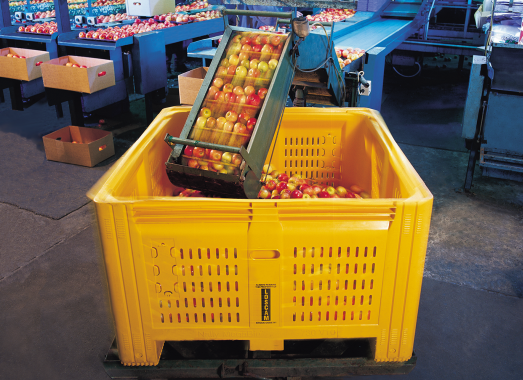If pallets are not handled effectively, this can drive up business costs and put the supply chain at risk. Losses from damaged products, ineffective storage solutions and safety problems can reduce both company profit and customer satisfaction. Once these costs are identified, businesses can apply targeted strategies to manage them more effectively.
Increased damage and replacement expenses
Poor handling and inspection practices allow damaged pallets to be in circulation, resulting in product harm and higher replacement costs. Cracked, splintered or warped pallets compromise load integrity and can lead to expensive breakages in transit or storage. The labour, material and downtime to repair or discard bad pallets quickly add up.
Additionally, replacement interrupts inventory flow and requires unplanned capital outlays. To avoid this businesses can establish regular inspection schedules, train personnel to identify defects early and maintain a repair station on-site to mitigate these expenses. Proactively repairing pallets extends service life, reduces the need for purchase and preserves load quality, so pallet damage does not snowball into hidden replacement costs.
Storage inefficiencies and space wastage
Warehouses without standardised stacking methods and proper storage layouts can quickly lose capacity in the form of haphazard pallet arrangements. Pallets that are misaligned or overhanging create voids that prevent vertical and horizontal stacking to the fullest extent, resulting in unused valuable cubic metres. The problem is exacerbated by inadequate racking or shelving systems that restrict safe load heights.
When space requirements increase, facilities have to rent additional storage or risk overcrowding the aisles, making forklift movement and throughput difficult. Pallet racks that are designed for uniform pallet dimensions and clear aisle protocols can recapture lost space with proper investment.
By implementing a digital mapping system to track pallet locations, planners can dynamically reorganise storage zones so that every square metre contributes to efficient inventory management rather than space being wasted due to poor pallet handling.
Operational delays and labour costs
Locating, sorting and disposing of defective pallets takes time away from daily workflows and adds labour overhead. For example, workers who have to physically separate good pallets from bad and sift through unorganised stacks waste productive hours that could otherwise be used to fulfil orders. Due to these inefficiencies, inbound receiving and outbound shipping cycle times become longer, which in turn leads to missed deadlines and customer dissatisfaction.
Furthermore, misplacements can also occur due to the lack of clear pallet tracking mechanisms, which can further increase retrieval times. Using barcodes or RFID tags to automate pallet identification speeds up sorting and gives real-time visibility of their status. Automated tracking and lean process training help reduce manual handling, streamline operations and lower labour costs related to the hidden delays that poor management can create.
Compliance risks and regulatory fines
Failure to conform to industry standards can place companies at risk of legal penalties and reputational damage. Pallets that do not meet weight capacity or hygiene regulations, jeopardise product safety and can violate rules in many industries, particularly in food and pharmaceuticals.
Often, pallet dimensions must adhere to transportation standards—such as the standard pallet size 1165 x 1165 mm—to be accepted for container loading and avoid additional charges. Carriers may reject non-compliant versions, which leads to delayed shipments and demurrage fees.
Prevention of violations is achieved by establishing a compliance checklist that refers to international pallet specifications, seals, wood treatment certifications and hygiene protocols. Regular audits and staff training on regulatory requirements ensures that pallets stay within legal and customer standards, protecting businesses from hidden costs associated with fines and shipment refusals.
Inventory loss and handling errors
Misplaced items, write-offs and inventory shrinkage are all attributed to inaccurate pallet tracking. Without clear identification of pallets or inconsistent labelling, stock counts become incorrect, leading to physical audits that waste resources. During transfers, improper equipment, such as makeshift supports instead of designated tools, causes pallets to tip or drop, scattering products and creating waste. Leaving loose items on unloading docks or storing irregular loads in unsuitable containers increases the risk of theft or misplacement. Automated warehousing solutions can be integrated with guided picking paths and visual cues to minimise handling errors.
In addition, the implementation of foldable bins for small or irregular items minimises the need for pallets for non-standard loads, enhancing accuracy. Better visibility and suitable storage gear reduce the hidden costs associated with inventory loss and handling errors.
Environmental impact and sustainability costs
Discarded or untreated wooden pallets contribute to deforestation and landfill overflow, incurring environmental fees and corporate sustainability penalties. Companies that ignore pallet recycling or refurbishment programs face disposal charges and the opportunity to recapture material value. The transportation of underused pallets produces carbon emissions and raises fuel costs, which increases their overall environmental impact.
Well-managed pallets reduce costs, increase productivity and improve safety. Better inventory processes, conducting inspections and providing training helps businesses cut costs in damaged goods, poor storage and fines for non-compliance. When incorporating proper equipment and eco-friendly methods, companies reduce both waste and their environmental impact. All in all, strong pallet management systems preserve the integrity of the supply chain, improve financial gains and contribute to an organisation’s long-term prosperity.






